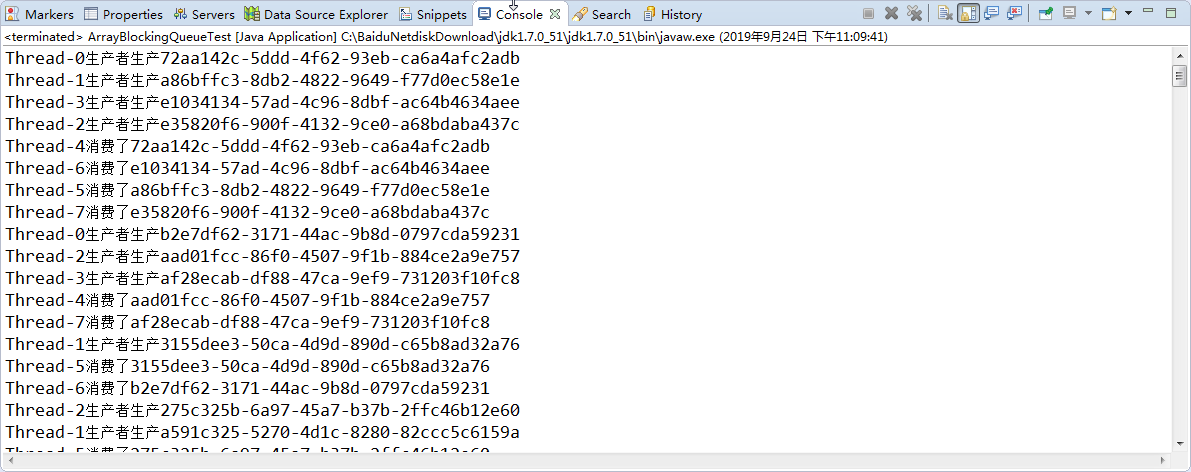blockingQueue 阻塞队列,一般用于消费者生产者模式。 就是通过ReentrantLock和condition实现的阻塞,
1 /** Main lock guarding all access */ 2 final ReentrantLock lock; 3 /** Condition for waiting takes */ 4 private final Condition notEmpty; 5 /** Condition for waiting puts */ 6 private final Condition notFull;
在我上一篇文章中简单用condition实现了消费者生产者模式。
https://www.cnblogs.com/liumy/p/11564375.html
本文的jdk版本是 jdk1.7
下面是阻塞对列的几个重要方法。

首先, 队列是 FIFO, 先进先出。 队列的头部是在队列中存活时间长的元素,而在队列尾部是存货时间短的元素。
下面是根据ArrayBlockingQueue来说明这些方法的实现。BlockingQueue的实现类有很多种,这里只是把共通的实现逻辑讲一下。
其中
抛出异常是指 当队列已满的时候,添加元素(add(e)),抛出IllegalStateException。当添加的对象为null时,会有空指针异常。在队列为空时,删除元素(remove()),会抛出NoSuchElementException。当执行element()方法时,如果队列为空,则抛出NoSuchElementException,反之,返回队列的头元素。
返回特殊值 是指,当队列已满时,执行offer方法在队列尾部添加元素时,会返回false,如果成功添加,则返回true。 当队列为空时,执行poll方法,返回为null,反之,则返回头部元素。
阻塞是指, 当队列已满,执行put方法,添加元素时,线程会阻塞,直到队列变得不满时,线程才会被唤醒,继续添加元素。当队列为空时,执行take方法,拉去元素时,线程会阻塞,直到队列有数据时,线程才继续执行。
超时是指 当队列已满,执行offer(e,time,unit)方法,添加元素时,线程会等待指定的时间,如果这个时间内队列还是满的,那么j就返回false,反之,则返回true。当队列为空,执行poll(time,unit)方法,拉取元素时,线程会等待指定的时间,如果这个时间内队列还是空的,则返回false,反之,返回true。
ArrayBlockingQueue.class
有下面这些成员变量。
/** * Serialization ID. This class relies on default serialization * even for the items array, which is default-serialized, even if * it is empty. Otherwise it could not be declared final, which is * necessary here. */ private static final long serialVersionUID = -817911632652898426L; /** The queued items */ final Object[] items; /** items index for next take, poll, peek or remove */ int takeIndex; /** items index for next put, offer, or add */ int putIndex; /** Number of elements in the queue */ int count; /* * Concurrency control uses the classic two-condition algorithm * found in any textbook. */ /** Main lock guarding all access */ final ReentrantLock lock; /** Condition for waiting takes */ private final Condition notEmpty; /** Condition for waiting puts */ private final Condition notFull;
blockingQueue 简单例子: 生产者消费者模式
package com.citi.test.mutiplethread.demo0503; import java.util.concurrent.ArrayBlockingQueue; import java.util.concurrent.BlockingQueue; public class ArrayBlockingQueueTest { public static void main(String[] args) { BlockingQueue<String> queue=new ArrayBlockingQueue<String>(4); new Thread(new Producer(queue)).start(); new Thread(new Producer(queue)).start(); new Thread(new Producer(queue)).start(); new Thread(new Producer(queue)).start(); new Thread(new Consumer(queue)).start(); new Thread(new Consumer(queue)).start(); new Thread(new Consumer(queue)).start(); new Thread(new Consumer(queue)).start(); } }
package com.citi.test.mutiplethread.demo0503; import java.util.Arrays; import java.util.UUID; import java.util.concurrent.BlockingQueue; public class Producer implements Runnable{ private BlockingQueue<String> queue; public Producer(BlockingQueue<String> queue) { this.queue=queue; } @Override public void run() { while(true){ try { String str=UUID.randomUUID().toString(); System.out.println(Thread.currentThread().getName()+"生产者生产"+str); queue.put(str); } catch (InterruptedException e) { // TODO Auto-generated catch block e.printStackTrace(); } try { Thread.sleep(1000); } catch (InterruptedException e) { // TODO Auto-generated catch block e.printStackTrace(); } } } }
package com.citi.test.mutiplethread.demo0503; import java.util.Arrays; import java.util.concurrent.BlockingQueue; public class Consumer implements Runnable{ private BlockingQueue<String> queue; public Consumer(BlockingQueue<String> queue) { this.queue=queue; } @Override public void run() { while(true){ try { String take = queue.take(); System.out.println(Thread.currentThread().getName()+"消费了"+take); } catch (InterruptedException e) { // TODO Auto-generated catch block e.printStackTrace(); } try { Thread.sleep(1000); } catch (InterruptedException e) { // TODO Auto-generated catch block e.printStackTrace(); } } } }

参考下面资料: